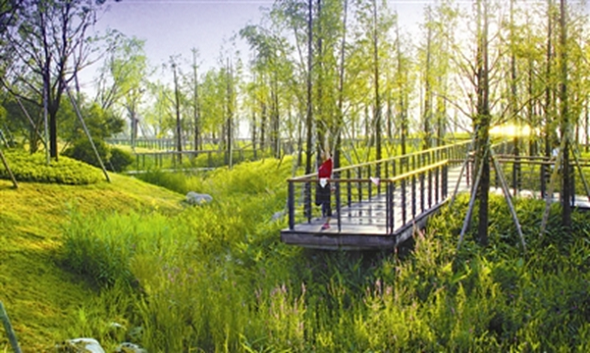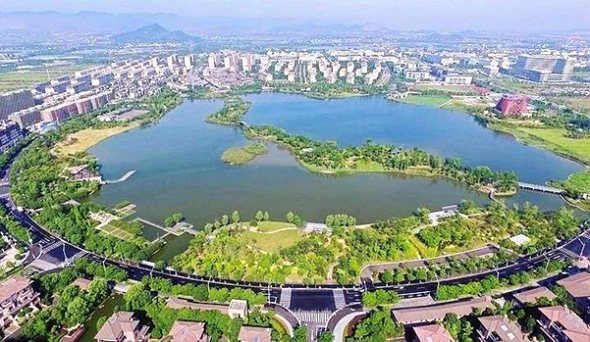
March 16, 2020, by Blue-Green team
Is the Sponge City Program (SCP) transforming Chinese Cities?
“We live in an isolated age.” An age where people are separated from nature and cities are disconnected from green fields. Today, Chinese cities are facing rapid urbanisation, leading to fast growing urban populations. For example, the population in Shanghai currently exceeds 24 million, in Guangzhou there are over 15 million, Beijing over 12 million, and Shenzhen over 10 million people. Chinese cities are also experiencing declines in urban environmental quality. Lei Li and Faith Chan (University of Nottingham Ningbo China) explore whether the Sponge City Program (SCP) can help reduce these risks through effective water cycle management.
Sponge City Program
The Sponge City Program (SCP) is a new concept for Chinese cities, aiming to manage urban stormwater by utilising Blue-Green Infrastructure (BGI). This will bring a more natural water cycle back into cities through accumulation, filtration, purification, storage and reuse of rainwater, as well as providing co-benefits to the environment and society. The SCP was proposed in December 2013 by the National Government. Several institutions, including the Ministries of Finance, Water Resources, and Housing and Rural-Urban Development, launched the pilot program. This comprised 16 pilot cities in the first batch and 14 pilot cities in the second batch.
The National Government issued SCP guidelines in October 2015, dictating that 20% of urban areas should include ‘sponge’ features (e.g. rain gardens, swales, wetlands, ponds and permeable paving). This increases to 70% by 2020 and 80% by 2030. Achieving this goal will mean retrofitting existing urban areas and implementing SCP measures in new towns and developments.
Ningbo
Ningbo was selected for the SCP in 2015. So far, efforts have improved the water quality in urban catchments and rivers. Nutrient levels have reduced and waterlogging has been alleviated, improving the urban living environment. There are some great examples, such as Shuanggudu Park (Figure 1), Eco-corridor in Ningbo New East town (Figure 2), New Ci Town (Figure 3), New Sanjiangkou Park, Xiejia Binjiang Park and Yaojiang Binjiang Park. Urban recreational space has increased significantly, and cities have become ecological and liveable. One of the SCP features in Ningbo is the combination of grey infrastructure and BGI, which effectively treat urban stormwater discharge and runoff.

Figure 1. Shuanggudu Park in Ningbo (source: Zhou, 2019)

Figure 2. Eco-corridor in Ningbo New East town (source: Ningbo Municipal Government, 2018)

Figure 3. The central lake in New Ci Town in Ningbo (source: Xie and Ying, 2017)
SCP in 2020
The SCP is now at a crossroads after almost 5 years since the program initiated. Doubts and uncertainties have been raised and there are queries from the media regarding the effectiveness. Headlines include: ‘Pilots of 30 sponge cities nationwide, 19 cities experienced flooding this year’ (Wang, 2016), ‘The “Sponge City” must address water uncertainty‘ (Beijing Youth Daily, 2016), ‘Sponge City is still waterlogged, related issues remain to be clarified’ (Hu, 2017). Only relying on the SCP and BGI cannot completely solve urban floods in Chinese cities.
Perceptions and functionality
Public perceptions of the function of Sponge Cities often differ to the technical guidance published by the National Government (Ministry of Housing and Urban-Rural Development (MOHURD), 2014). Chan et al. (2018) argued that according to the SCP guidelines, infrastructure can only withstand 1-in-30 year return period stormwater events. SCP measures are not designed for intensive rainstorms (e.g. generated by typhoons) or climatic extremes (high magnitude floods and droughts). They are an important part of the solution to managing flood risk in Chinese cities, but not the only part.
We want to emphasis that the SCP cannot solve all urban flood and water management issues. We encourage stakeholders to be patient and give the SCP time to be completed, and benefits to accrue. SCP projects offer many benefits, and, importantly, are implemented is public places (e.g. urban wetland parks). This increases recreational opportunities and may help improve social wellbeing (e.g. health and happiness) and environmental awareness of future challenges (e.g. climate change, land use change).
“We should bear in mind that profound changes in attitudes, behaviours and policies will be required to create a world in which human beings live in harmony with nature.”
Sam Kahamba Kutesa, UN General Assembly President, during the Dialogue on Harmony with Nature (UN News, 2015).
Understanding of urban ecosystems and planning of future cities require comprehensive thinking and innovative design, and perhaps a little imagination and passion. The SCP provides opportunity to boost up the greenery and nature in Chinese cities, while managing water challenges.
Authors:
Lei Li (Postgraduate Researcher on Nature Based Solutions, Green Infrastructure and Sponge Cities, School of Geographical Sciences, University of Nottingham Ningbo China)
Faith Chan (Associate Professor, School of Geographical Sciences, University of Nottingham Ningbo China)
References
- Beijing Youth Daily (2016). The “Sponge City” must address water uncertainty.
- Chan, F. K. S., et al. (2018). “Sponge City” in China—A breakthrough of planning and flood risk management in the urban context. Land Use Policy, 76, 772–778.
- General Office of the State Council (2015). Guiding Opinions of the General Office of the State Council on Promoting the Construction of the Sponge City. Beijing, People’s Republic of China: General Office of the State Council.
- Ministry of Housing and Urban-Rural Development (MOHURD). (2014). The construction guideline of Sponge City in China. Low impact development of storm water system. Beijing, People’s Republic of China: MOHURD.
- Hu, H.D. (2017). Sponge City is still waterlogged, related issues remain to be clarified. Shanghai Information platform. December 12, Available at: http://www.istis.sh.cn/list/list.aspx?id=10935. (Accessed: 6 March 2020).
- Ningbo Municipal Government (2018). The new appearance of Ningbo New East Town Eco-Corridor Phase II and Yongxin River Park. Available at: http://gtoc.ningbo.gov.cn/art/2018/9/30/art_168_951559.html (Accessed: 6 March 2020).
- Sidner, L. (2017). Sponge City: Solutions for China’s Thirsty and Flooded Cities, NewSecurityBeat, June 21, Available at: https://www.newsecuritybeat.org/2017/07/sponge-city-solutions-chinas-thirsty-flooded-cities/ (Accessed: 6 March 2020).
- Statement at the Interactive Dialogue on Harmony with Nature | General Assembly of the United Nations. Available at: http://www.un.org/pga/270415_statement-interactive-dialogue-on-harmony-with-nature/ (Accessed: 6 March 2020).
- Wang H.R. (2016) A pilot of 30 sponge cities nationwide, 19 cities have experienced flooding this year, China Economic Weekly, (35), 48-50.
- Xie, Y. and Ying, L. (2017). Sponge city, people and water in harmony, Ningbo Ci Town leads in creating a “Sponge” demonstration area Zhejiang News, Available at: https://zj.zjol.com.cn/news/731728.html?ismobilephone=1&t=1529196447898 (Accessed: 6 March 2020).
- Zhou, K.N. (2019). What is the “visible” effect of Ningbo sponge city construction? What can be shared? Zhejiang News, Available at: http://zjnews.zjol.com.cn/zjnews/nbnews/201902/t20190227_9545808.shtml (Accessed: 6 March 2020).
No comments yet, fill out a comment to be the first

Leave a Reply